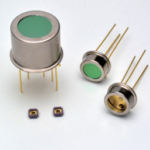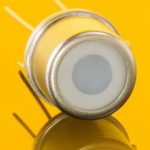Boston Electronics photodetectors span the spectrum from UV, Visible, to IR and THz, and are applied in a wide range of markets and applications including remote sensing, chemical and gas detection, disinfection and water purification, and scientific instrumentation to just name a few. Our on-line resources and application specialist will help you determine the most appropriate sensor for your application.
We have two main classes of IR detectors; room temperature and TE-cooled, quantum detectors, preamplifiers, controllers and accessories; and low-cost thermopile room temperature thermal detectors. These cover the spectral range from 2 to 14 um and beyond, thus addressing a wide range of requirements.
temperature and TE-cooled, quantum detectors, preamplifiers, controllers and accessories; and low-cost thermopile room temperature thermal detectors. These cover the spectral range from 2 to 14 um and beyond, thus addressing a wide range of requirements.
Our UV photodiodes, sensors, probes and  measurement systems utilize the proven highest reliability technology available (silicon carbide, SiC). A wide range of spectral coverage is available from UV/blue/visible down to deep UVC, supporting UV applications.
measurement systems utilize the proven highest reliability technology available (silicon carbide, SiC). A wide range of spectral coverage is available from UV/blue/visible down to deep UVC, supporting UV applications.
We have unique visible silicon hybrid photodetectors that provide 0 – 5 V amplified output and cover a large range of sensitivities and wide spectral coverage (290-1010 nm).
To see more detailed information on these devices, click to visit the following pages, or follow the product category links at the bottom of the page.
- UV detectors – high reliability, high dose resistant SiC UV photodiodes, sensors and probes
- IR quantum detectors – high speed, high performance (wavelengths 2 to 12+ microns) and CO2 laser detection (nominal 10.6 microns), high bandwidth QWIP.
- IR thermopile and pyroelectric thermal detectors – non-contact temperature measurement and gas concentration sensing.
- THz detectors – Fast, high performance THz receivers, pyroelectric and Superconducting Hot Electron Bolometer (SHEB).
- Visible Si Hybrid detectors – picowatt/cm2 to Watt/cm2 sensitivity with 0 – 5 V amplifed output.
- Vacuum Sensors – MEMS Type Pirani Vacuum Sensors
We also supply low cost, infrared imaging arrays that are rapidly being adopted into many applications that previously could not imagine thermal imaging as affordable. See our separate section for these sensors.
- IR imaging arrays (wavelengths typically between 3 and 14um)








